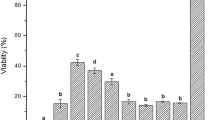Abstract
Freeze-drying ofCryptococcus terricolus cells in distilled water resulted in a survival of only 0.1% of the cells. The viability could be increased to 16% by the use of a dextran-sucrose-sodium glutamate solution as suspending medium.
For freeze-dried material with both low and high survival rates, and for five as well as for ten days old cultures, malt extract solution was the superior reconstitution medium. Less, but still distinct, protective action was found with a synthetic glucose-urea-salt solution.
The viable cell counts of cells freeze-dried in dextran-sucrose-sodium glutamate solution were independent of the medium used for plating. When distilled water was used as a medium for freeze-drying, two to four times higher counts were obtained with malt extract agar than with synthetic glucose-urea-salt agar.
Of the twenty different media tried for freeze-drying, sucrose solution gave the best protection. The viability was greatly influenced by the concentration used, maximum values being obtained when more than 10% of sucrose was added. The survival rate increased with the age of the cells until the fifth day, but was independent of the concentration of cells in the suspension. Under optimum conditions a survival rate of more than 80% was reached.
Similar content being viewed by others
References
Atkin, L., Moses, W. andGray, P. P. 1949. The preservation of yeast cultures by lyophilization. J. Bacteriol.57: 575–578.
Brady, B. L. 1960. Some observations on the freeze-drying of yeasts.In A. S. Parkes and A. U. Smith, [ed.], Recent research in freezing and drying. Blackwell Scientific Publications, Oxford.
Fry, R. M. 1954. The preservation of bacteria. p. 215–252.In R. J. C. Harris, [ed.], Biological applications of freezing and drying. Academic Press, New York.
Fry, R. M. andGreaves, R. I. N. 1951. The survival of bacteria during and after drying. J. Hyg.49: 220–246.
Greaves, R. I. N. 1960. Preservation of living cells by freeze-drying.In Freezing and drying of biological materials. Ann. N.Y. Acad. Sci.85: Art. 2: 501–734.
Guibert, L. etBréchot, P. 1955. La lyophilisation des levures. Première partie. Ann. Inst. Pasteur88: 750–768.
Haynes, W. C., Wickerham, L. J. andHesseltine, C. W. 1955. Maintenance of cultures of industrially important micro-organisms. Appl. Microbiol.3: 361–368.
Heckly, R. J. 1961. Preservation of bacteria by lyophilization. Advances in Appl. Microbiol.3: 1–76.
Kirsop, B. 1955. Maintenance of yeast by freeze-drying. J. Inst. Brewing61: 466–471.
Leach, R. H. andScott, W. J. 1959. The influence of rehydration on the viability of dried micro-organisms. J. Gen. Microbiol.21: 295–307.
Mazur, P. 1962. Mechanisms of injury in frozen and frozen-dried cells. p. 59–70.In S. M. Martin, [ed.], Culture collections: perspectives and problems. Proceedings of the specialists' conference on culture collections, Ottawa. University of Toronto Press, 1963.
Pedersen, T. A. 1958.Cryptococcus terricolus nov. spec., a new yeast isolated from Norwegian soils. Compt. Rend. Trav. Lab. Carlsberg31: 93–103.
Pedersen, T. A. 1961. Lipid formation inCryptococcus terricolus I. Nitrogen nutrition and lipid formation. Acta Chem. Scand.15: 651–662.
Pedersen, T. A. 1963. Lipid formation inCryptococcus terricolus V. Oxidation of fatty acids by cell suspensions. Physiologia Plantarum16: 151–166.
Scott, W. J. 1960. A mechanism causing death during storage of dried micro-organisms. p. 188–202.In Second intern. symp. on freezing and drying. Blackwell Scientific Publications, Oxford.
Straka, R. P. andStokes, J. L. 1959. Metabolic injury to bacteria at low temperatures. J. Bacteriol.78: 181–185.
Terui, G. andIkeda, J. 1962. The effect of some treatments for starvation upon the viability of yeast cells through lyophilization p. 193–197.In S. M. Martin, [ed.], Culture collections: perspectives and problems. Proceedings of the specialists' conference on culture collections, Ottawa. University of Toronto Press, 1963.
Wickerham, L. J. andFlickinger, M. H. 1946. Viability of yeasts preserved two years by the lyophil process. Brewers Dig.21: 55–59 and 65.
Author information
Authors and Affiliations
Rights and permissions
About this article
Cite this article
Pedersen, T.A. Factors affecting viable cell counts of freeze-driedCryptococcus terricolus cells. Antonie van Leeuwenhoek 31, 232–240 (1965). https://doi.org/10.1007/BF02045903
Received:
Issue Date:
DOI: https://doi.org/10.1007/BF02045903



